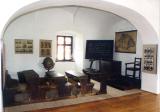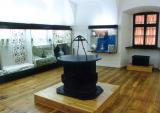2025. July 14. Monday
Scientific Collections of the Sárospatak Calvinist School - Sárospatak
 |
Address: 3950, Sárospatak Rákóczi út 1.
Phone number: (47) 315-256
E-mail: reftud@iif.hu
Opening hours: Mon-Sat 9-17, Sun 9-13
01.11-01.05 Sat-Sun.: position closed |
The museum building stands in dignity in the court of the Sárospatak Calvinist School. The museum keeps the message of the past from the end of the 18th century. The building was built between 1771 and 1772 by master Tamás Lieb.
The only building of the Berna-row represents the protestant baroque era of educational institutes. Its building was initiated by Györgynek Szathmáry-Király. He was supervising as well as financially supporting the building works.
During the centuries a few collections were established in order to provide better representations to the students. However, for certain destructions we can only trace them from the beginning of the 18th century.
The fundaments of the "Museum Physicum" were laid down by professor István Simándi (1965-1710). In 1709 he brought valuable items from his West-Eeuropean journeys. He was the one who first taught experimental physics in Hungary. A good part of these items can still be seen in the Museum (e.g. Laterna Magica, Air Pump...) István Simándi was followed by excellent scientists in teaching physics: Dávid Barczafalvi Szabó, Mózes Kézy, József Ellend. The school even sent items the millennium and the world exhibition held in Paris. The coin collection was established when the museum was founded. The first inventory record mentions 34 coins.
The natural science collection was formed at the end of the 18th century. This collection belonged to the the state secondary school in 1952, but in 1990 it was again replaced to the Calvinist Secondary Grammar School.
We can follow up the material of our archeology collection from the year of 1800. Up to the 1960'ies there was a gradual grow, but since then there have been only 1-2 items registered annually.
The Fine Art collection was founded by Lajos Felmeri (1840-1894) in 1871, on his return from Europe. He began collecting the ancient and the modern art reconstructions. The grow is still continuous today.
Károly Jakob (1890-1951) had been the keeper of the ancient relics collection since 1930. On the 400th anniversary of the school (1931) they demonstrated the nicest items of the museum materials. In 1944 the first publication was published. It was a writing by Károly Jakab about the ancient collection.
In 1952, when the educational institute was nationalized, the musicological collection was extended by the ethnography material of the Village Seminary of the Theology. In recent decades the collection was enriched by significant Calvinist and foreign ethnographic items.
The museum registered 25.637 items in December 2002. The collection's main source is from donations and heritages. Our main collection target is still school history and ecclesiastic art. We also carry on with collecting documents, objects and photos connecting to the history of the school. We would like to protect the items (textiles, popular art items, utility tools, etc.) of the past. We also keep a good number of items that documentate the events of our present time.
We endeavor to protect these objects of cultural value as our national treasure.
The only building of the Berna-row represents the protestant baroque era of educational institutes. Its building was initiated by Györgynek Szathmáry-Király. He was supervising as well as financially supporting the building works.
During the centuries a few collections were established in order to provide better representations to the students. However, for certain destructions we can only trace them from the beginning of the 18th century.
The fundaments of the "Museum Physicum" were laid down by professor István Simándi (1965-1710). In 1709 he brought valuable items from his West-Eeuropean journeys. He was the one who first taught experimental physics in Hungary. A good part of these items can still be seen in the Museum (e.g. Laterna Magica, Air Pump...) István Simándi was followed by excellent scientists in teaching physics: Dávid Barczafalvi Szabó, Mózes Kézy, József Ellend. The school even sent items the millennium and the world exhibition held in Paris. The coin collection was established when the museum was founded. The first inventory record mentions 34 coins.
The natural science collection was formed at the end of the 18th century. This collection belonged to the the state secondary school in 1952, but in 1990 it was again replaced to the Calvinist Secondary Grammar School.
We can follow up the material of our archeology collection from the year of 1800. Up to the 1960'ies there was a gradual grow, but since then there have been only 1-2 items registered annually.
The Fine Art collection was founded by Lajos Felmeri (1840-1894) in 1871, on his return from Europe. He began collecting the ancient and the modern art reconstructions. The grow is still continuous today.
Károly Jakob (1890-1951) had been the keeper of the ancient relics collection since 1930. On the 400th anniversary of the school (1931) they demonstrated the nicest items of the museum materials. In 1944 the first publication was published. It was a writing by Károly Jakab about the ancient collection.
In 1952, when the educational institute was nationalized, the musicological collection was extended by the ethnography material of the Village Seminary of the Theology. In recent decades the collection was enriched by significant Calvinist and foreign ethnographic items.
The museum registered 25.637 items in December 2002. The collection's main source is from donations and heritages. Our main collection target is still school history and ecclesiastic art. We also carry on with collecting documents, objects and photos connecting to the history of the school. We would like to protect the items (textiles, popular art items, utility tools, etc.) of the past. We also keep a good number of items that documentate the events of our present time.
We endeavor to protect these objects of cultural value as our national treasure.

